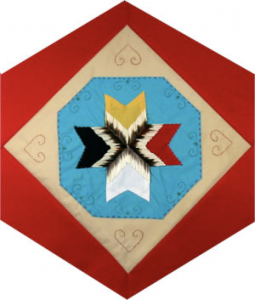Mi’gmaq

The Block
Using various techniques such as embroidery, appliqué and porcupine quillwork, Carol Caplin of Listuguj (Restigouche), Quebec, created the central eight-pointed star. This star is a centuries-old Mi’gmaq symbol of unity. The colours of the star represent the four races of people: red, yellow, black, and white. the number four has significance throughout Mi’gmaq culture. The points show the four compass directions and speaks to the importance of maintaining balance in the external environment and within oneself. Doubled to eight points, the design implies that there is always something more than meets the eye, a recurring theme known as “The Great Mystery” in Mi’gmaq cosmology. Elders explain the eight-point star as representing the original seven Mi’gmaq districts plus the 1752 agreement with the Crown that made all inseparable from one another.
In the corners, stitched double curves, or two-dimensional spirals, represent the positive and negative forces of nature’s spiral-like movements in the currents of the wind and ocean. The blue background of the sky surrounds all.
Cultural Profile
The Mi’gmaq are believed to be the first natives ever encountered by Vikings, known to have reached the eastern shores of Canada around 1000 AD. The Mi’gmaq were original members of the Wabanaki Confederacy along with the Abenaki, Penobscot, Maliseet and Passamaquoddy. They ranged from southern Gaspé Peninsula through the Maritime Provinces, up into Newfoundland and down into Maine. Their name, Mi’gmaq (spelling variations include Mi’kmaq and Micmac), means “allies” and comes from their language Mi’kmawi’simk, of the Algonquian linguistic family. This language was written in pictographs as seen in ancient petroglyphs (rock drawings) located at McGowan Lake and Fairy Bay in Kejimikujic Park, Nova Scotia.
A nomadic people, the Mi’gmaq used wigwams that were easily moved as they traveled to hunt, trap, fish and harvest wild berries. They also made distinctive birchbark canoes and toboggans. Now a commonly used English word, ‘toboggans’ comes from the M’igmaq word taba’gan. They collected sap and made maple syrup every spring to use as a flavourful cooking additive. The Mi’gmaq were masters of porcupine quillwork, a technique used to decorate clothing, moccasins and baskets. The quills from the Eastern Porcupine, madooes, are white with black tips; traditionally certain sizes of quills were used for different types of quillwork.
The Mi’gmaq were among the first aboriginal peoples to trade with the European explorers and settlers. During the wars in the mid-1700s they sided with the French against the British and their Iroquois allies. When the British won they unsuccessfully attempted to convert the Mi’gmaq to farming in the 1760s. Unable to reconcile to a sedentary lifestyle of farming many Mi’gmaq became involved in the forestry and transportation industries. Today the Mi’gmaq population in the Maritimes is over 15,000 strong. There is also a number of Mi’maq communities in Quebec and Newfoundland. Many modern-day Mi’gmaq work in traditional salmon fishing.
Sponsor: Listuguj Mi’gmaq First Nation Council
